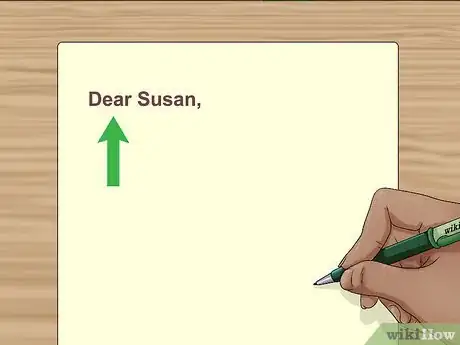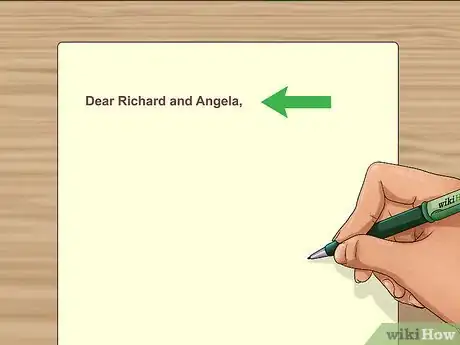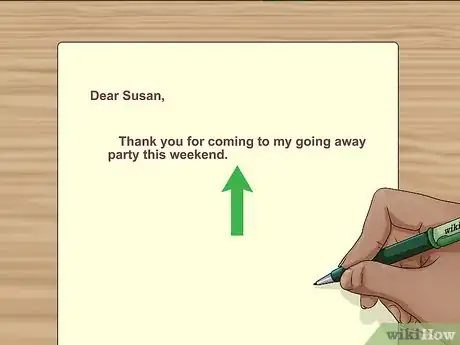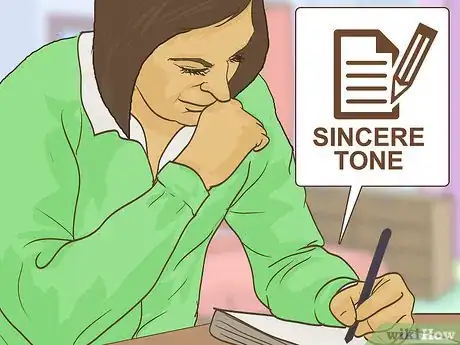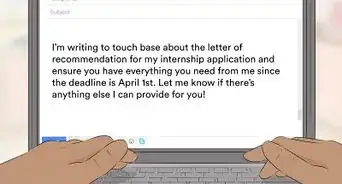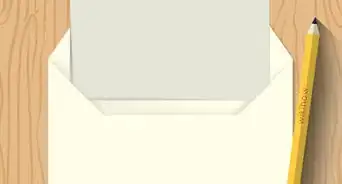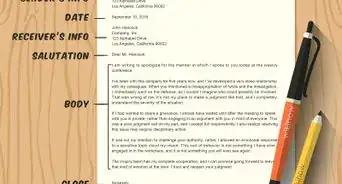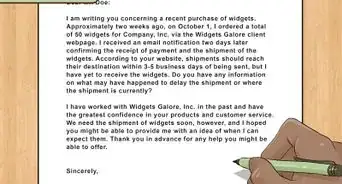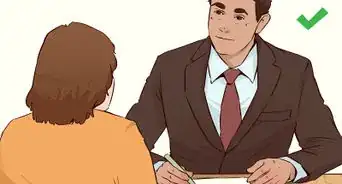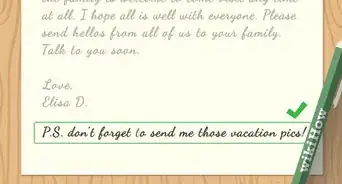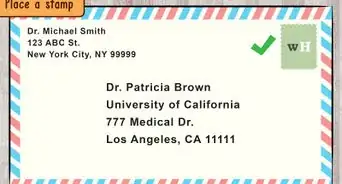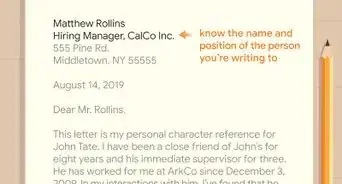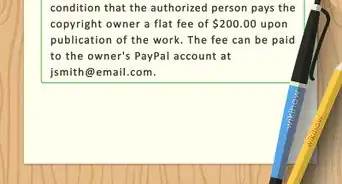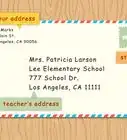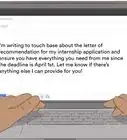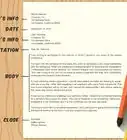This article was co-authored by Tami Claytor. Tami Claytor is an Etiquette Coach, Image Consultant, and the Owner of Always Appropriate Image and Etiquette Consulting in New York, New York. With over 20 years of experience, Tami specializes in teaching etiquette classes to individuals, students, companies, and community organizations. Tami has spent decades studying cultures through her extensive travels across five continents and has created cultural diversity workshops to promote social justice and cross-cultural awareness. She holds a BA in Economics with a concentration in International Relations from Clark University. Tami studied at the Ophelia DeVore School of Charm and the Fashion Institute of Technology, where she earned her Image Consultant Certification.
There are 8 references cited in this article, which can be found at the bottom of the page.
This article has been viewed 18,823 times.
Thank-you letters are a time-honored gesture of appreciation, but capturing the right tone isn’t always easy. Because of the increasing rarity of formal letters, many people find themselves grasping for the right words when they sit down to pen a personalized response. The result is a message that comes off sounding stilted or robotic. Luckily, it’s easy enough to avoid this obstacle by following one simple rule: be sincere. A good thank-you letter should come from the heart. Start by addressing the intended recipient clearly, then state the purpose of the letter and express your gratitude in a way that comes naturally to you.
Steps
Opening Your Thank-You Letter
-
1Start with a basic header. It’s hard to go wrong with a simple “Dear Susan,” as the introductory address of your message. If for some reason this feels inappropriate, it’s also acceptable to simply begin with a name. The most important thing is that the recipient be able to see right away that the letter is intended for their eyes.[1]
- Though they’re a more traditional method of correspondence, thank-you letters aren’t inherently formal, so there’s no need employ overly proper language.
- Avoid vague, impersonal headers like “dear valued client” or “to whom it may concern.”[2]
-
2Identify the intended recipient clearly. Address the person or people you’re sending the letter to by their first name, except in professional situations. “Dear Richard and Angela” sounds much more personable than “dear friend” or even “dear Thompsons.” To avoid any embarrassing mistakes, double check to make sure you’ve spelled the recipient’s name correctly.[3]
- If you’re not on a first-name basis with the recipient, it’s okay to use a last name or official title, such as “Mr. Jeffries” or “Chairwoman Diaz.”[4]
- Letters addressed to a large group or organization should use the entire name of the group (“Dear Boys and Girls Club of Detroit”). Don’t neglect to also send letters individually to specific people who have helped you.
Advertisement -
3Express your gratitude in the first sentence. Since the whole reason you’re writing is to offer thanks, they should come first and foremost in the letter. Don’t distract your reader with a lengthy preamble. Let them know right away what to expect from the letter they’ve just opened.[5] [6]
- Keep it simple: “Thank you for coming to my going away party this weekend” or “I’m writing to let you know how much I loved your gift” are both explicit and to the point.
-
4Follow up with more specific details. After you’ve extended a few words of appreciation, elaborate on how much the recipient’s actions meant to you. Refer directly to the part the recipient played in the event that prompted the letter. This could involve describing how you’ve put a gift to use, highlighting a personal connection or displaying your excitement over their attendance.[7] [8]
- You might thank your son or daughter’s new in-laws by writing “it was so lovely meeting you and getting a chance to share such a joyous experience.”
- The same guidelines apply if the letter is being sent in response to a professional opportunity. Statements like “the grant money I received will be put to good use aiding my research into aboriginal tribes” point to a connection between something the recipient has done and your desire to acknowledge them.[9]
Writing an Effective Letter
-
1Strike a sincere tone. Be candid and express yourself naturally in your own words, as though you were speaking to a close friend. Don’t overthink what it is you’re trying to say. Seek to convey a gracious attitude without downplaying or overstating the scope of the recipient’s deeds.[10]
- Make sure the recipient knows their efforts are appreciated. There’s little point in taking the time to draft a thank-you letter if you don’t actually sound thankful.
- Too much enthusiasm can make your letter seem forced, while too little may cause it to be perceived as a perfunctory gesture.
-
2Keep the letter brief. In general, it’s best to limit your message to a couple hundred words or less. Otherwise, you run the risk of losing your reader’s attention. Short letters are easier to digest, which is important, since they may be read several times. Say what you need to say, wish the person well, then sign off.[11]
- As a general rule, aim for 5-7 sentences to serve as the body of the letter.
- Confine your message to a notecard or small piece of stationery so you don’t end up rambling in an effort to fill up space.[12]
-
3Include a personal touch. As a bonus, you might take a moment to reinforce your admiration for the recipient in a way that will stand out to them. Adding a small side note like “it was a real treat to see you lecture at Berkeley a few weeks back” or “you and Mark make such a handsome couple!” can be very gratifying to your reader and indicate that you’re keeping up with the details of their life as well as your own.[13] [14]
- It may seem inappropriate to make observations about someone you haven’t made or don’t know personally.
Organizing and Sending Letters
-
1Make a list of everyone you plan to thank. Think about who you’ll be writing to and make a note of their name and the specific act you’re thanking them for. It’s important to send a letter to everyone who has given up time, money or energy to help you so that no one feels overlooked.[15]
- Single out prominent individuals who have helped you and write them all separately.
- Families can be addressed collectively under the name of the household.
-
2Take the time to write individual letters. Composing multiple thank-you letters can be a demanding task, but if you’re going to do it, you should make an effort to do it the right way. Approach each letter you begin as its own distinct work. Resist the urge to simply copy the content of one letter over to another with the names changed.[16]
- Tackle a long list of thank-yous one at a time to keep from getting overwhelmed.
- It can help to stick to a basic template or format for each letter that will allow you to get your point across without forcing you to come up with something entirely different every time.[17]
-
3Send out thank-you letters promptly. The best time to dispatch a thank-you letter is immediately after the favor has been performed. That way, the event is still fresh in both parties’ minds, so there will be no confusion as to the letter’s focus. It will also come across as much more genuine if you make it a point to express your gratitude sooner rather than later.[18]
- Start the letter-writing process at your earliest convenience to give yourself plenty of time to get them completed.
- If for some reason you’re late in mailing a thank-you letter, politely explain the delay to your reader.
Community Q&A
Did you know you can get expert answers for this article?
Unlock expert answers by supporting wikiHow
-
QuestionHow do I end a thank you letter?
 Tami ClaytorTami Claytor is an Etiquette Coach, Image Consultant, and the Owner of Always Appropriate Image and Etiquette Consulting in New York, New York. With over 20 years of experience, Tami specializes in teaching etiquette classes to individuals, students, companies, and community organizations. Tami has spent decades studying cultures through her extensive travels across five continents and has created cultural diversity workshops to promote social justice and cross-cultural awareness. She holds a BA in Economics with a concentration in International Relations from Clark University. Tami studied at the Ophelia DeVore School of Charm and the Fashion Institute of Technology, where she earned her Image Consultant Certification.
Tami ClaytorTami Claytor is an Etiquette Coach, Image Consultant, and the Owner of Always Appropriate Image and Etiquette Consulting in New York, New York. With over 20 years of experience, Tami specializes in teaching etiquette classes to individuals, students, companies, and community organizations. Tami has spent decades studying cultures through her extensive travels across five continents and has created cultural diversity workshops to promote social justice and cross-cultural awareness. She holds a BA in Economics with a concentration in International Relations from Clark University. Tami studied at the Ophelia DeVore School of Charm and the Fashion Institute of Technology, where she earned her Image Consultant Certification.
Etiquette Coach
References
- ↑ http://www.thesimpledollar.com/how-to-write-an-effective-thank-you-note-for-any-occasion/
- ↑ http://sumac.com/how-to-write-the-perfect-thank-you-letter/
- ↑ http://www.themorningnews.org/article/how-to-write-a-thank-you-note
- ↑ https://www.scribendi.com/advice/how_to_write_a_formal_letter.en.html
- ↑ http://ideas.hallmark.com/articles/thank-you-ideas/how-to-write-a-thank-you-note/
- ↑ Tami Claytor. Etiquette Coach. Expert Interview. 29 September 2020.
- ↑ http://www.themorningnews.org/article/how-to-write-a-thank-you-note
- ↑ Tami Claytor. Etiquette Coach. Expert Interview. 29 September 2020.
- ↑ http://www.fresnostate.edu/studentaffairs/scholarships/faq/thankyouletter.html
- ↑ https://www.gailperry.com/how-to-craft-a-killer-thank-you-letter/
- ↑ http://www.thesimpledollar.com/how-to-write-an-effective-thank-you-note-for-any-occasion/
- ↑ http://www.themorningnews.org/article/how-to-write-a-thank-you-note
- ↑ http://www.thesimpledollar.com/how-to-write-an-effective-thank-you-note-for-any-occasion/
- ↑ Tami Claytor. Etiquette Coach. Expert Interview. 29 September 2020.
- ↑ http://ideas.hallmark.com/articles/thank-you-ideas/how-to-write-a-thank-you-note/
- ↑ https://www.gailperry.com/how-to-craft-a-killer-thank-you-letter/
- ↑ http://www.thesimpledollar.com/how-to-write-an-effective-thank-you-note-for-any-occasion/
- ↑ http://ideas.hallmark.com/articles/thank-you-ideas/how-to-write-a-thank-you-note/
